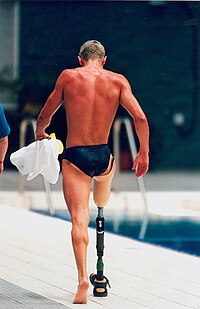
Photo from wikipedia
Objective: This study describes differentiating prosthetic feet designs fitted to bone-anchored transtibial prostheses based on an automated characterization of ankle stiffness profile relying on direct loading measurements. The objectives were,… Click to show full abstract
Objective: This study describes differentiating prosthetic feet designs fitted to bone-anchored transtibial prostheses based on an automated characterization of ankle stiffness profile relying on direct loading measurements. The objectives were, first, to present a process characterizing stiffness using innovative macro, meso, and micro analyses, second, to present stiffness profiles for feet with and without anthropomorphic designs, where anthropomorphicity is defined as a similarity of the moment-angle dependency in prosthetic and in the anatomical ankle, and third, to determine the sensitivity of characterization. Methods: Three participants walked consecutively, with two instrumented bone-anchored prostheses, including their own prosthetic feet and free-flow foot, meeting the anthropomorphicity criterion by design. Angle of dorsiflexion was extracted from video footage. Bending moment was recorded using multi-axis transducer attached to osseointegrated fixation. The automated characterization of stiffness involved a 12-step process relying on data-based criterion. Results: The meso analyses confirmed bilinear behavior of moment-angle curves with Index of Anthropomorphicity of −2.966 ± 2.369 Nm/Deg and 2.681 ± 1.089 Nm/Deg indicating a convex and concave shape of usual and free-flow feet without and with anthropomorphic designs, respectively. Conclusions: The proposed straightforward meso analysis of the stiffness was capable to report clinical meaningful differences sensitive to feet's anthropomorphicity. Results confirmed the benefits for clinicians to rely on direct loading measurement providing individualized complementary insight into impact of components. Significance: This work could assist the development of standards and guidelines for the manufacturing and safe fitting of components to a growing population requiring transtibial prostheses with socket or direct skeletal attachment worldwide.
Journal Title: IEEE Transactions on Biomedical Engineering
Year Published: 2019
Link to full text (if available)
Share on Social Media: Sign Up to like & get
recommendations!